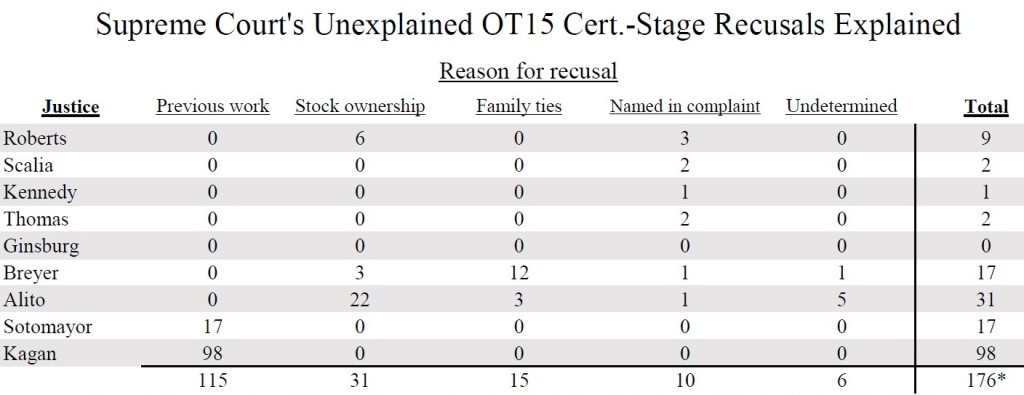The Justices Recused Themselves an Astounding 180 Times Last Term
Fix the Court has found that Supreme Court justices recused themselves an astonishing 180 times – 176 times at the cert. stage and four times when a case was granted – during the term that ended in June, mostly due to prior work and stock holdings.
While Justices Kagan and Sotomayor can’t dissociate themselves from previous jobs, Chief Justice Roberts and Justices Breyer and Alito forfeited their “duty to sit” 31 times this term in order to hold on to relatively minor investments in companies with cases before the court.
“The justices often speak about the high bar they set for themselves when deciding whether to step aside from a case since, unlike in other federal courts, Supreme Court justices are not ‘fungible,’” Fix the Court executive director Gabe Roth said. “That said, they should do all they can to be sure they can consider a petition or hear a case, and that means three of them should not be holding a random assortment of investments that may lead to a shorthanded bench.”
Though the two cases with stock-based recusals that were argued before the high court in OT15 had clear majorities – FERC v. EPSA and Puerto Rico v. Franklin (both Alito recusals) were decided 6-2 and 5-2, respectively – it is possible that any number of the 31 petitions with stock-based conflicts were missing a key fourth vote at the cert. stage, leaving decisions on issues ranging from patents to false claims to class actions in the hands of lower court judges.
Taken together, Fix the Court’s “Second Half of OT15 Recusal Report” released today along with its first half report released in December show how the breadth of stock ownership by these three justices may be affecting the docket.
Here’s our analysis of the reasons why 91 times between January and June a Supreme Court justice “took no part” in a cert. determination. Here’s the list of the second half OT15 recusals as they were described in the court’s weekly orders. And here’s that list as an easy-to-reference chart.
In the past nine months, Roberts’ ownership of Time Warner Cable, Microsoft and AOL shares triggered a total of six cert.-stage recusals; Breyers’ ownership of Cisco, IBM and Lowe’s triggered three and Alito’s ownership of Boeing, CR Bard, Du Pont, Jacobs Engineering, Johnson & Johnson, Kinder Morgan, Merck, Oracle, PNC, Proctor & Gamble, Schlumberger and Wells Fargo shares triggered at least 22.[1]
If justices have a duty to sit, why aren’t they doing more to reduce the need for recusal?
Fix the Court’s recusal report also underscores the length of time it takes for cases to go from tort to high court. One of Justice Sonia Sotomayor’s disqualifications, in RJR Nabisco v. European Community, occurred because she had heard the case as a circuit court judge in 2003, while one of Justice Kagan’s recusals stems from a 2004 conviction of an Oklahoma man for dealing meth out of an auto repair shop. Both Alito and Roberts were circuit court judges in 2003-2004, so it is possible that in future terms their previous work could trigger a recusal.
Looking at other reasons for OT15 recusals, Justice Breyer’s brother, Charles, is still hearing cases at a regular clip in the Northern District of California (despite his senior status), and Justice Alito’s sister, Rosemary, is a partner at K&L Gates, a firm with many high profile clients. These relationships triggered a total of 15 cert.-stage recusals in OT15.
Finally, a few justices were named in filings this term. Of the four such suits, three were filed by individuals whose repetitive, “vexatious” petitions seemed to test the limits of the justices’ patience.
[1] We write “at least” because of the 180 recusals of OT15, Fix the Court was not able to determine the reasons behind six of them – five of which were Alito recusals.
